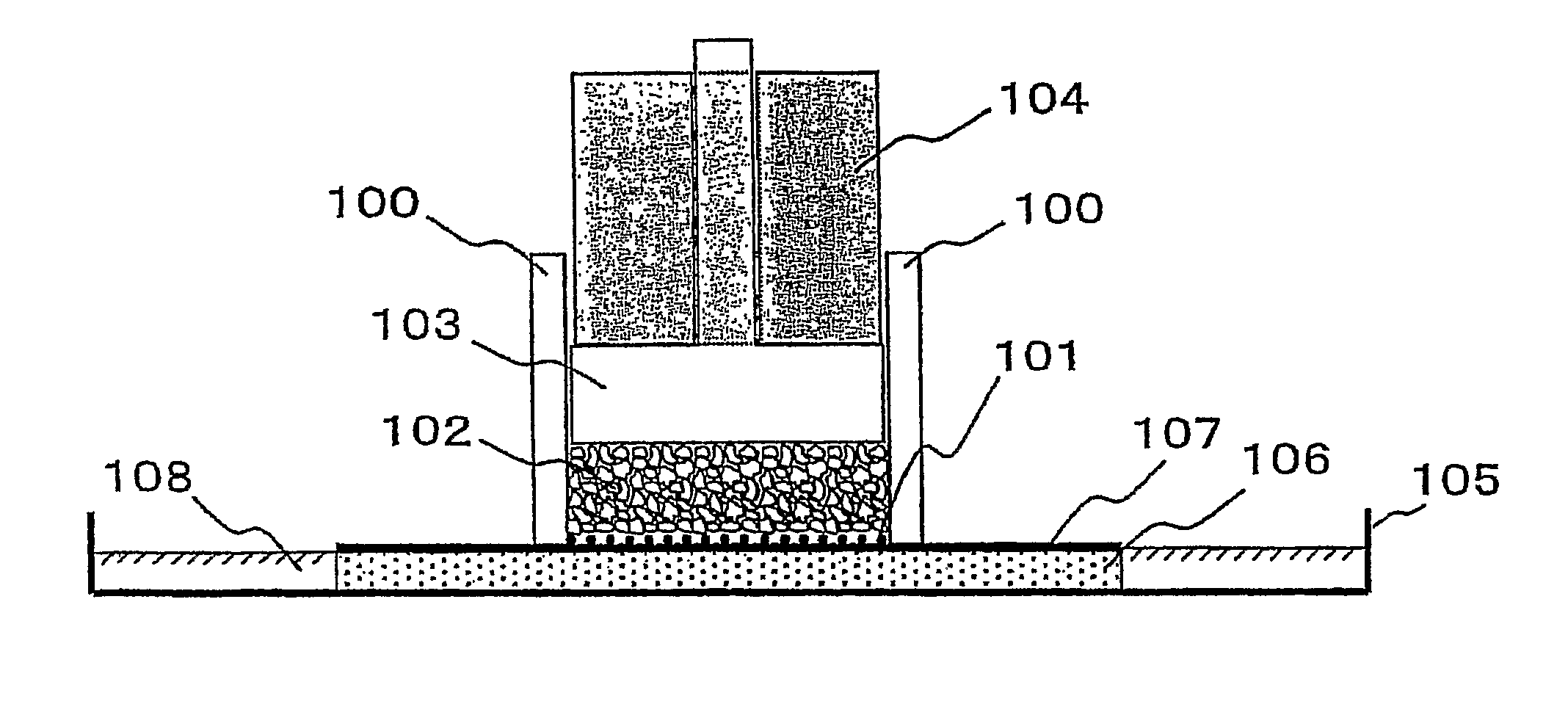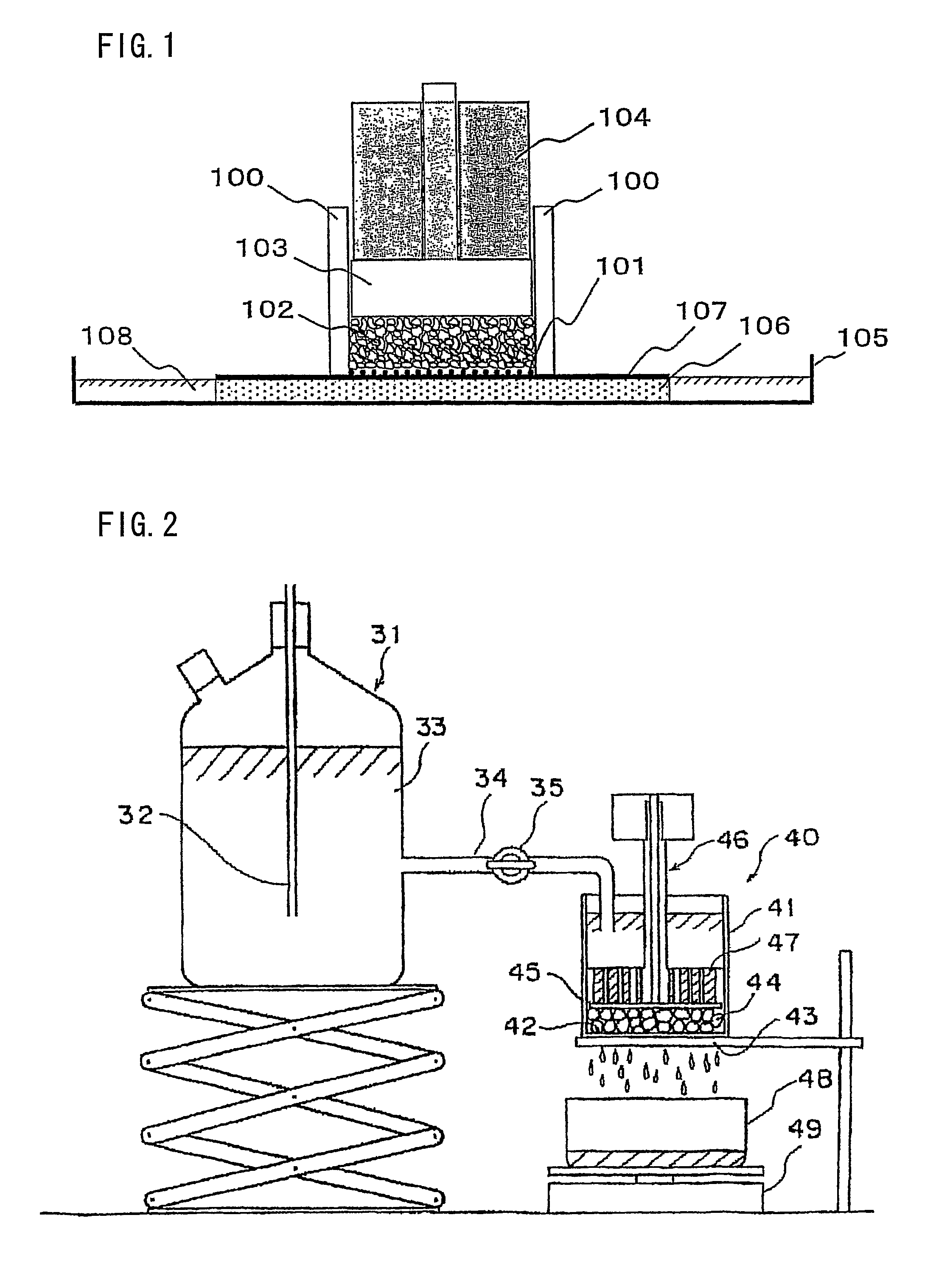Water absorbent resin production method, water absorbent resin, and usage thereof
a water absorbent resin and production method technology, applied in the direction of coatings, emulsion paints, etc., can solve the problems of large gel pieces, undried product difficulty in processing, and inability to fragment cross-linked polymer hydrogel as finely as in a case, etc., to achieve stable performance, stabilize the variation in crc, and different internal cross-linking degrees
- Summary
- Abstract
- Description
- Claims
- Application Information
AI Technical Summary
Benefits of technology
Problems solved by technology
Method used
Image
Examples
example 1
1-1
[0211]In a reaction container formed by providing a lid on a 10-liter stainless double-arm kneader equipped with two sigma vanes and a jacket, there was prepared a reaction solution by dissolving 436.4 g of acrylic acid, 4617.9 g of 37 mass % aqueous solution of sodium acrylate, 397.7 g of pure water, 8.87 g (0.07 mol %) of polyethylene glycol diacrylate (molecular weight of 523), and 0.437 g (0.02 mol %) of 1,4-butanediol. Next, this reaction solution was deaerated under an atmosphere of nitrogen gas for 20 minutes. Subsequently, 14.53 g of 20 mass % aqueous solution of sodium persulfate and 24.22 g of 0.1 mass % aqueous solution of L-ascorbic acid were added thereto under stirred conditions. As a result, polymerization initiated about 34 seconds after the addition. The polymerization was carried out at a temperature in the range from 25° C. to 92° C. while the formed gel was crushed. Then, the resultant cross-linked polymer hydrogel was retrieved 30 minutes after the initiation...
example 2
2-1
[0219]The operation was performed as in Example 1, but the amount of 1,4-butanediol was 0.873 g (0.04 mol %) instead of 0.437 g (0.02 mol %) in Example 1. The resultant cross-linked polymer hydrogel was fragmented into pieces substantially having gel particle diameters of about 5 mm or less, but some of them had gel particle diameters of 10 mm or greater.
2-2
[0220]The fragmented cross-linked polymer hydrogel particles were spread out on a metal gauze of 50 mesh and dried by hot air at 180° C. for 50 minutes. From a dried product thus obtained, undried gel or rubber-like particles were removed. The amount of the removed undried product was 91 g.
2-3
[0221]The dried product was pulverized with a roll mill and then classified with JIS standard sieves having mesh sizes of 710 μm and 175 μm, respectively, thus obtaining a water absorbent resin of irregularly pulverized shape.
2-4
[0222]The operation as in [2-1] through [2-3] was performed a total of five times. Then, the respective centrif...
example 3
3-1
[0226]The operation was performed as in Example 1, but the amount of 1,4-butanediol was 1.310 g (0.06 mol %) instead of 0.437 g (0.02 mol %) in Example 1. The resultant cross-linked polymer hydrogel was fragmented into pieces substantially having gel particle diameters of about 5 mm or less, but some of them had gel particle diameters of 10 mm or greater.
3-2
[0227]The fragmented cross-linked polymer hydrogel particles were spread out on a metal gauze of 50 mesh and dried by hot air at 180° C. for 50 minutes. From a dried product thus obtained, undried gel or rubber-like particles were removed. The amount of the removed undried product was 88 g.
3-3
[0228]The dried product was pulverized with a roll mill and then classified with JIS standard sieves having mesh sizes of 710 μm and 175 μm, respectively, thus obtaining a water absorbent resin of irregularly pulverized shape.
3-4
[0229]The operation as in [3-1] through [3-3] was performed a total of five times. Then, the respective centrif...
PUM
| Property | Measurement | Unit |
|---|---|---|
| molar ratio | aaaaa | aaaaa |
| molar ratio | aaaaa | aaaaa |
| Absorbency Against Pressure | aaaaa | aaaaa |
Abstract
Description
Claims
Application Information
 Login to View More
Login to View More - R&D
- Intellectual Property
- Life Sciences
- Materials
- Tech Scout
- Unparalleled Data Quality
- Higher Quality Content
- 60% Fewer Hallucinations
Browse by: Latest US Patents, China's latest patents, Technical Efficacy Thesaurus, Application Domain, Technology Topic, Popular Technical Reports.
© 2025 PatSnap. All rights reserved.Legal|Privacy policy|Modern Slavery Act Transparency Statement|Sitemap|About US| Contact US: help@patsnap.com



